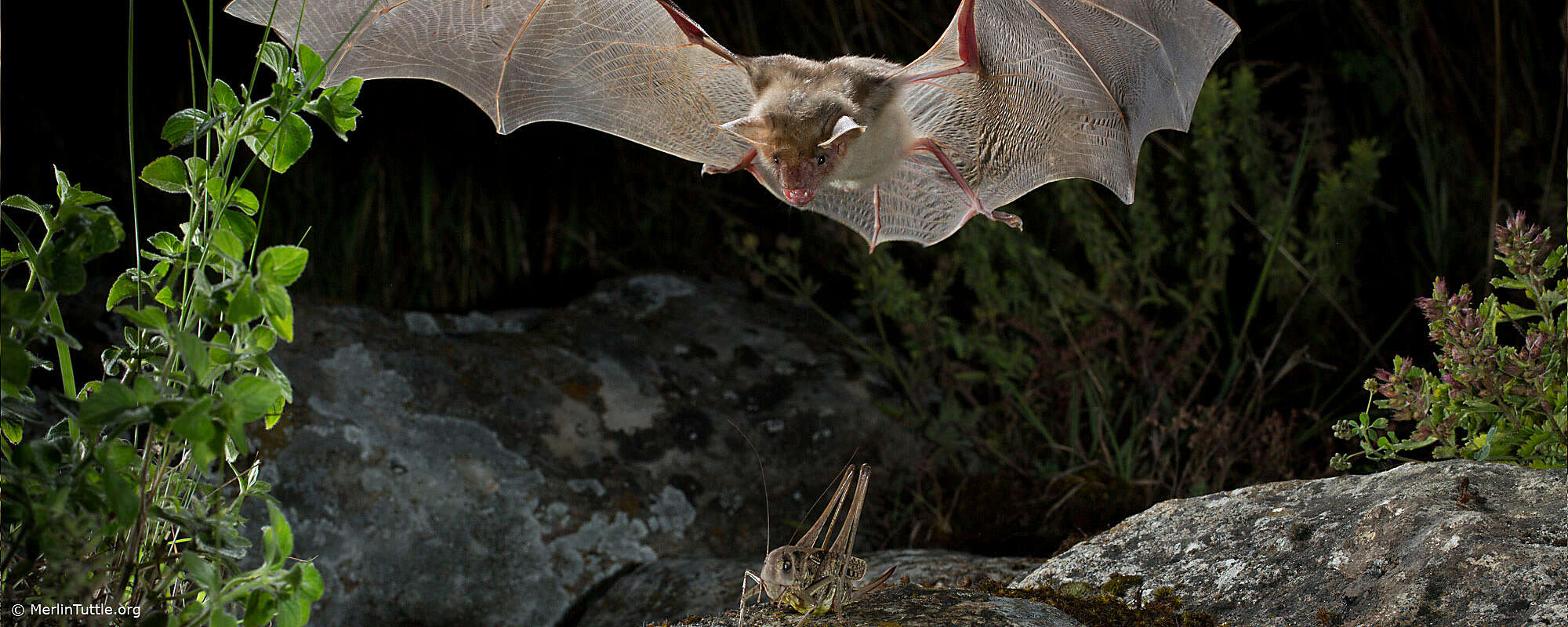
The vast majority and all of our native bats feed exclusively or predominantly on insects and other arthropods, such as spiders. The prey is taken either in flight or directly from the ground. Bats that specialise in picking up insects from the ground usually have highly sensitive hearing, which enables them to recognise prey even by the smallest rustling sounds. Something similar can be observed in owls, which locate a mouse by its rustling.
Fruit bats eat only fruits, flowers, nectar, pollen or leaves and are thus considered vegetarians among bats. However, fruits do not contain all the nutrients needed by the bats in sufficient quantities. Therefore, a large proportion of the nitrogen they need, for example, is taken in by eating pollen and leaves. There are also bat species in the tropics of the American continent (the so-called New World tropics) that feed on fruits, nectar and pollen. However, they belong to the leaf-nosed bats and not to the fruit bats, which do not occur in the New World. Fruit-eating leaf-nosed bats occasionally hunt insects to meet their nitrogen requirements. Among fruit-eating and especially nectar-eating bats, one can see numerous adaptations to their diet (see physique). Interestingly, some plants have also adapted to their mammalian pollinators. For example, several plant species in the New World tropics have developed echo reflectors on the flowers or leaves that can be detected and found very quickly by the echolocating bats and thus used by the plants to attract their pollinators.
Other bats are specialised in hunting vertebrates such as small mammals, reptiles or amphibians and picking them up from the ground. Particularly spectacular are the fish-catching bats, such as the fisherman bat (Noctilio leporinus), which use their echolocation to scan the surface of the water and, when approaching a fish, drop their enlarged feet with sharp claws into the water and use them to spear small fish.

Although the thought of Count Dracula is probably one of the first to awaken in many people when they think of bats, there are only three species of bats in the world that actually feed on blood. All three species (the common vampire bat Desmodus rotundus, the Hairy-Legged Vampire BatDiphylla ecaudata, and the white-winged vampire bat (Diaemus youngi) are native to Central or South America; no blood-licking bats occur in the rest of the world. Incidentally, vampire bats are the only mammals that feed exclusively on the blood of other animals. They are characterised by numerous adaptations to this special way of feeding. For example, their saliva contains an anaesthetic that allows the vampire bats to remove a piece of the prey's skin unnoticed with their sharp incisors, as well as an anticoagulant that maintains the blood flow for a long time after the bite. The substances contained in the saliva are now also used as medicines for people with heart disease. The animals' digestive tract and kidneys are also highly specialised and designed to process food quickly. Just two minutes after the start of the meal, the animals begin to urinate in order to reduce their weight and thus maintain their ability to fly. Unlike mosquitoes, for example, vampire bats do not suck the blood of their prey, but lick it. Two of the three species of vampire bats are mainly specialised on birds, while the third species uses large mammals as a source of blood. The licking of blood by the vampire bats themselves does not pose a great danger to the infested animals, as the amount of blood absorbed is too small. However, pathogens such as rabies, which are transmitted with the bite, can be dangerous.
However, vampire bats are not only known for their unusual feeding behaviour, but also for their distinct social behaviour. These bats feed each other with highly strangulated blood if one of the colony members was unsuccessful in the nightly hunt and thus keep themselves from starving by helping each other.
you're not there yet? Then register directly:
register for projects
register as teacher
Sie sind noch nicht dabei? Dann direkt anmelden. Jetzt Registrieren